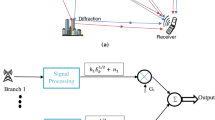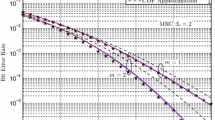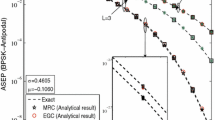Abstract
In this paper, the performance of wireless system employing microdiversity to mitigate the effects of short-term fading and macrodiversity to reduce long-term fading (shadowing) effects is studied. The system model assumes implementation of maximal-ratio combining (MRC) at the microlevel and selection combining (SC) at the macrolevel. The received signal envelope follows a Rician distribution and it also suffers gamma shadowing. Novel expressions for the probability density function (PDF), cumulative distribution function (CDF), and moment-generating function (MGF) of the output signal-to-noise ratio (SNR) are obtained. Several useful performance criteria, such as the moments of the output SNR and outage probability are analytically derived. Moreover, the average bit error probability (ABEP) for noncoherent binary differential phase-shift keying (BDPSK) is calculated using the MGF based approach while the ABEP for coherent binary phase-shift keying (BPSK) is studied by averaging the conditional bit error probability over the PDF. Numerical results are graphically presented to show the effects of various system parameters to the system performance, as well as the enhancement due to use of the combination of micro- and macrodiversity. Some of numerical results are complemented by equivalent computer simulated results which validate the accuracy of the proposed analysis. The agreement between the Rician-gamma and Rician-lognormal fading model is also established.
Similar content being viewed by others
References
Tse D., Viswanath P. (2005) Fundamentals of wireless communication. Cambridge University Press, Cambridge
Simon M. K., Alouini M.-S. (2000) Digital communication over fading channels (1st ed.). Wiley, New York
Goldsmith A. (2005) Wireless communications. Cambridge University Press, Cambridge
Lee W. C. Y. (1997) Mobile communication engineering (2nd ed.). McGraw-Hill, New York
Hansen F., Mano F. I. (1977) Mobile fading-Rayleigh and lognormal superimposed. IEEE Transactions on Vehicular Technology 26(4): 332–335
Suzuki H. (1977) A statistical model for urban radio propagation. IEEE Transactions on Communications 25(7): 673–680
Zhang J., Aalo V. (2001) Effect of macrodiversity on average-error probabilities in a Rician fading channel with correlated lognormal shadowing. IEEE Transactions on Communications 49(1): 14–18
Al-Hussaini E. K., Al-Bassiouni A. M., Mouradand H., Al-Shennawy H. (2002) Composite macroscopic and microscopic diversity of sectorized macrocellular and microcellular mobile radio systems employing RAKE receiver over Nakagami fading plus lognormal shadowing channel. Wireless Personal Communications 21(3): 309–328
Abdi, A., & Kaveh, M. (1999). On the utility of gamma PDF in modeling shadow fading (slow fading). IEEE vehicular technology conference, Houston, TX, Vol. 3, pp. 2308–2312.
Kostic I. (2005) Analytical approach to performance analysis for channel subject to shadowing and fading. IEE Proceedings Communications 152(6): 821–827
Shankar P. M. (2006) Performance analysis of diversity combining algorithms in shadowed fading channels. Wireless Personal Communications 37(1–2): 61–72
Shankar P. M. (2008) Analysis of microdiversity and dual channel macrodiversity in shadowed fading channels using a compound fading model. International Journal of Electronics and Communications (AEÜ) 62(6): 445–449
Shankar P. M. (2008) Outage probabilities of a MIMO scheme in shadowed fading channels with micro- and macrodiversity reception. IEEE Transactions on Wireless Communications 7(6): 2015–2019
Shankar P. M. (2009) Macrodiversity and microdiversity in correlated shadowed fading channels. IEEE Transactions on Vehicular Technology 58(2): 727–732
Gradshteyn I. S., Ryzhik I. M. (1994) Table of integrals, series, and products (5th ed.). Academic, New York
Yue S., Ouarda T. B. M. J., Bobee B. (2001) A review of bivariate gamma distributions for hydrological application. Journal of Hydrology 246(1–4): 1–18
Xekalaki E., Panaretos J., Psarakis S. (2003) A predictive model evaluation and selection approach—the correlated gamma ratio distribution. In: Panaretos J. (Ed.) Stochastic musings: Perspectives from the pioneers of the late 20th century. Psychology Press, USA, pp 188–202
Papoulis A. (1991) Probability, random variables, and stochastic processes (3rd ed.). McGraw-Hill, New York
Win M. Z., Mallik R. K., Chrisikos G. (2003) Higher order statistics of antenna subset diversity. IEEE Transactions on Wireless Communications 2(5): 871–875
Sagias N. C., Karagiannidis G. K. (2005) Gaussian class multivariate Weibull distributions: Theory and applications in fading channels. IEEE Transactions on Information Theory 51(10): 3608–3619
Tellambura C., Annamalai A., Bhargava V. K. (2001) Unified analysis of switched diversity systems in independent and correlated fading channels. IEEE Transactions on Communications 49(11): 1955–1965
Abramovitz M., Stegun I. A. (1972) Handbook of mathematical functions with formulas, graphs, and mathematical tables. Dover, New York
Author information
Authors and Affiliations
Corresponding author
Rights and permissions
About this article
Cite this article
Sekulović, N.M., Stefanović, M.Č. Performance Analysis of System with Micro- and Macrodiversity Reception in Correlated Gamma Shadowed Rician Fading Channels. Wireless Pers Commun 65, 143–156 (2012). https://doi.org/10.1007/s11277-011-0232-8
Published:
Issue Date:
DOI: https://doi.org/10.1007/s11277-011-0232-8




